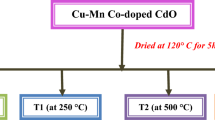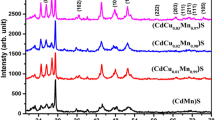Abstract
Heterovalent doping represents an effective method to control the optical and electronic properties of semiconductor nanocrystals (NCs), such as the luminescence and electronic impurities (p-, n-type doping). Considering the phase structure diversity, coordination varieties of Cu atoms in Cu2S NCs, and complexity of Cu doping in II-VI NCs, monodisperse Cu2S NCs with pure hexagonal phase were synthesized firstly. Then through cation exchange reaction between Cd ions and well-defined Cu2S NCs, dominant Cu(I) doped CdS NCs were produced successfully. The substitutional Cu(I) dopants with controllable concentrations were confirmed by local atom-specific fine structure from X-ray absorption near edge structure (XANES), extended X-ray absorption fine structure (EXAFS) spectroscopy, elemental analysis characterizations from X-ray photoelectron spectroscopy (XPS) and the electron spin resonance (ESR) measurement. The dominant and strong Cu(I) dopant fluorescence was verified by their absorption and photoluminescence (PL) spectra, and PL lifetime. Finally, the band positions and the p-type conductivities of the as-prepared Cu2S and Cu(I) doped CdS NCs were identified by ultraviolet photoelectron spectroscopy (UPS) measurements. The high monodispersity of NCs enables their strong film-scale self-assembly and will hasten their subsequent applications in devices.
中文摘要
异价掺杂, 能有效调控半导体纳米晶的电学及光学性能, 实现高效掺杂发光及n型、p型导电类型的调控. 因为Cu2S晶型多 变、Cu原子配位繁杂以及Cu掺杂II-VI纳米晶的体系复杂等问题, 本文提出一种全新的方法, 首先可控制备了单分散的高纯度六方相 Cu2S纳米晶, 然后通过可控的离子交换反应, 合成了单分散Cu(I)掺杂的CdS纳米晶. 通过X射线近边吸收谱(XANES)、扩展X射线吸收 精细结构(EXAFS)、X射线光电子能谱(XPS)及电子顺磁共振波谱(EPR)等精确表征手段证实了可控浓度的取代型的异价Cu掺杂. 其紫 外-可见吸收光谱、荧光光谱、荧光寿命光谱等表征证实了以Cu(I)掺杂为主导的掺杂发光, 绝对量子产率可达28.9%. 紫外光电子能谱 (UPS)确认了Cu(I)掺杂的CdS为p型半导体. 高度单分散的CdS掺杂纳米晶可以形成大规模的自组装, 将会加速其在光电器件上的应用.
Similar content being viewed by others
References
Erwin SC, Zu LJ, Haftel MI, et al. Doping semiconductor nanocrystals. Nature, 2005, 436: 91–94
Norris DJ, Efros AL, Erwin SC. Doped nanocrystals. Science, 2008, 319: 1776–1779
Beaulac R, Schneider L, Archer PI, Bacher G, Gamelin DR. Light-induced spontaneous magnetization in doped colloidal quantum dots. Science, 2009, 325: 973–976
Mocatta D, Cohen G, Schattner J, et al. Heavily doped semiconductor nanocrystal quantum dots. Science, 2011, 332: 77–81
Viswanatha R, Battaglia DM, Curtis ME, et al. Shape control of doped semiconductor nanocrystals (d-Dots). Nano Res, 2008, 1: 138–144
Viswanatha R, Brovelli S, Pandey A, Crooker SA, Klimov VI. Copper- doped inverted core/shell nanocrystals with “permanent” optically active holes. Nano Lett, 2011, 11: 4753–4758
Sahu A, Kang MS, Kompch A, et al. Electronic impurity doping in CdSe nanocrystals. Nano Lett, 2012, 12: 2587–2594
Jana S, Srivastava BB, Acharya S, et al. Prevention of photooxidation in blue-green emitting Cu doped ZnSe nanocrystals. Chem Commun, 2010, 46: 2853–2855
Xie Y, Carbone L, Nobile C, et al. Metallic-like stoichiometric copper sulfide nanocrystals: phase- and shape-selective synthesis, near-infrared surface plasmon resonance properties, and their modeling. ACS Nano, 2013, 7: 7352–7369
Bekenstein Y, Vinokurov K, Keren-Zur S, et al. Thermal doping by vacancy formation in copper sulfide nanocrystal arrays. Nano Lett, 2014, 14: 1349–1353
Cooper JK, Gul S, Lindley SA, Yano J, Zhang JZ. Tunable photoluminescent core/shell Cu+-doped ZnSe/ZnS quantum dots codoped with Al3+, Ga3+, or In3+. ACS Appl Mater Interfaces, 2015, 7: 10055–10066
Brovelli S, Galland C, Viswanatha R, Klimov VI. Tuning radiative recombination in Cu-doped nanocrystals via electrochemical control of surface trapping. Nano Lett, 2012, 12: 4372–4379
Srivastava BB, Jana S, Pradhan N. Doping Cu in semiconductor nanocrystals: some old and some new physical insights. J Am Chem Soc, 2011, 133: 1007–1015
Isarov AV, Chrysochoos J. Optical and photochemical properties of nonstoichiometric cadmium sulfide nanoparticles: surface modification with copper(II) ions. Langmuir, 1997, 13: 3142–3149
Sambasivam S, Sathyaseelan B, Raja Reddy D, Reddy BK, Jayasankar CK. ESR and photoluminescence properties of Cu doped ZnS nanoparticles. Spectrochim Acta Part A, 2008, 71A: 1503–1506
Zheng HM, Rivest JB, Miller TA, et al. Observation of transient structural-transformation dynamics in a Cu2S nanorod. Science, 2011, 333: 207–209
Leidinger P, Popescu R, Gerthsen D, Lunsdorf H, Feldmann C. Nanoscale copper sulfide hollow spheres with phase-engineered composition: covellite (CuS), digenite (Cu1.8S), chalcocite (Cu2S). Nanoscale, 2011, 3: 2544–2551
Riha SC, Jin S, Baryshev SV, et al. Stabilizing Cu2S for photovoltaics one atomic layer at a time. ACS Appl Mater Interfaces, 2013, 5: 10302–10309
Zhuang ZB, Peng Q, Zhang BC, Li YD. Controllable synthesis of Cu2S nanocrystals and their assembly into a superlattice. J Am Chem Soc, 2008, 130: 10482–10483
Desnica UV. Doping limits in II-VI compounds—challenges, problems and solutions. Prog Cryst Growth Charact Mater, 1998, 36: 291–357
Kashiwaba Y, Kanno I, Ikeda T. p-type characteristics of Cudoped CdS thin films. Jpn J Appl Phys, 1992, 31: 1170–1175
Huang Q, Li Q, Xiao XD. Hydrogen evolution from Pt nanoparticles covered p-type CdS:Cu photocathode in scavenger-free electrolyte. J Phys Chem C, 2014, 118: 2306–2311
Son DH, Hughes SM, Yin Y, Alivisatos AP. Cation exchange reactions- in ionic nanocrystals. Science, 2004, 306, 1009–1012
Gui J, Ji MW, Liu JJ, Xu M, Zhang JT. Phosphine-initiated cation exchange for precisely tailoring composition and properties of semiconductor nanostructures: old concept, new applications. Angew Chem Int Ed, 2015, 127, 3754–3758
Qian HM, Zhao Q, Dai B S, et al. Oriented attachment of nanoparticles to form micrometer-sized nanosheets/nanobelts by topotactic reaction on rigid/flexible substrates with improved electronic properties. NPG Asia Mater, 2015, 7: e152
Deng ML, Wang LY. Unexpected luminescence enhancement of upconverting nanocrystals by cation exchange with well retained small particle size. Nano Res, 2014, 7: 782–793
Beberwyck BJ, Surendranath Y, Alivisatos AP. Cation exchange: a versatile tool for nanomaterials synthesis. J Phys Chem C, 2013, 117: 19759–19770
Kang MS, Sahu A, Frisbie CD, Norris DJ. Influence of silver doping on electron transport in thin films of PbSe nanocrystals. Adv Mater, 2013, 25: 725–731
Liu J, Zhao Q, Liu JL, et al. Heterovalent-doping-enabled efficient dopant luminescence and controllable electronic impurity via a new strategy of preparing II-VI nanocrystals. Adv Mater, 2015, 27: 2753–2761
Li S, Wang HZ, Xu WW, et al. Synthesis and assembly of monodisperse spherical Cu2S nanocrystals. J Colloid Interface Sci, 2009, 330: 483–487
Rivest JB, Fong LK, Jain PK, Toney MF, Alivisatos AP. Size dependence of a temperature-induced-solid phase transition in copper(I) sulfide. J Phys Chem Lett, 2011, 2: 2402
Wang PP, Yang Y, Zhuang J, Wang X. Self-adjustable crystalline inorganic nanocoils. J Am Chem Soc, 2013, 135: 6834–6837
Zhu Y, Li Z, Chen M, et al. One-pot preparation of highly fluorescent cadmium telluride/cadmium sulfide quantum dots under neutral- pH condition for biological applications. J Colloid Interface Sci, 2013, 390: 3–10
Pan D, Wang Q, Pang J, et al. Semiconductor “nano-onions” with multifold alternating CdS/CdSe or CdSe/CdS structure. Chem Mater, 2006, 18: 4253–4258
Xuan T, Wang S, Wang X, et al. Single-step noninjection synthesis of highly luminescent water soluble Cu+ doped CdS quantum dots: application as bio-imaging agents. Chem Commun, 2013, 49: 9045–9047
Rockenberger J, Troger L, Kornowski A, et al. EXAFS studies on the size dependence of structural and dynamic properties of CdS nanoparticles. J Phys Chem B, 1997, 101: 2691–2701
Gul S, Cooper JK, Glans P, et al. Effect of Al3+ co-doping on the dopant local structure, optical properties, and exciton dynamics in Cu+-doped ZnSe nanocrystals. ACS Nano, 2013, 7: 8680–8692
Sun ZH, Liu QH, Yao T, Yan WS, Wei SQ. X-ray absorption fine structure spectroscopy in nanomaterials. Sci China Mater, 2015, 58: 313–341
Grandhi GK, Viswanatha R. Tunable infrared phosphors using Cu doping in semiconductor nanocrystals: surface electronic structure evaluation. J Phys Chem Lett, 2013, 4: 409–415
Wang XB, Yan XS, Li WW, Sun K. Doped quantum dots for whitelight-emitting diodes without reabsorption of multiphase phosphors. Adv Mater, 2012, 24: 2742–2747
Meinardi F, Colombo A, Velizhanin KA, et al. Large-area luminescent solar concentrators based on ‘stokes-shift-engineered’ nanocrystals in a mass-polymerized PMMA matrix. Nat photonics, 2014, 8: 392–399
Krumer Z, Pera SJ, van Dijk-Moes RJA, et al. Tackling self-absorption in luminescent solar concentrators with type-II colloidal quantum dots. Sol Energ Mater Sol Cell, 2013, 111: 57–65
Chun WJ, Ishikawa A, Fujisawa H, et al. Conduction and valence band positions of Ta2O5, TaON, and Ta3N5 by UPS and electrochemical methods. J Phys Chem B, 2003, 107: 1798–1803
Cho KS, Lee EK, Joo WJ, et al. High-performance crosslinked colloidal quantum-dot light-emitting diodes. Nat Photonics, 2009, 3: 341–345
Author information
Authors and Affiliations
Corresponding author
Additional information
Jian Liu was born in Jiangsu, China, in 1991. He received his BSc degree in 2013 from the University of Shanghai for Science and Technology, and is now studying at Beijing institute of technology for his MSc degree. His research interest includes doping semiconductor nanocrystals.
Jiatao Zhang was born in 1975. He received his PhD degree in 2006 from the Department of Chemistry, Tsinghua University, China. Currently he is Xu Teli Professor in the School of Materials and Engineering, Beijing Institute of Technology. He was awarded Excellent Young Scientist foundation of NSFC in 2013. He also serves as the director of Beijing Key Laboratory of Construction-Tailorable Advanced Functional Materials and Green Applications. His current research interest is inorganic chemistry of semiconductor based hybrid nanostructures to possess novel optical, electronic properties for applications in energy conversion and storage, catalysis, optoelectronics and biology.
Electronic supplementary material
Rights and permissions
About this article
Cite this article
Liu, J., Zhao, Y., Liu, J. et al. From Cu2S nanocrystals to Cu doped CdS nanocrystals through cation exchange: controlled synthesis, optical properties and their p-type conductivity research. Sci. China Mater. 58, 693–703 (2015). https://doi.org/10.1007/s40843-015-0080-z
Received:
Accepted:
Published:
Issue Date:
DOI: https://doi.org/10.1007/s40843-015-0080-z




